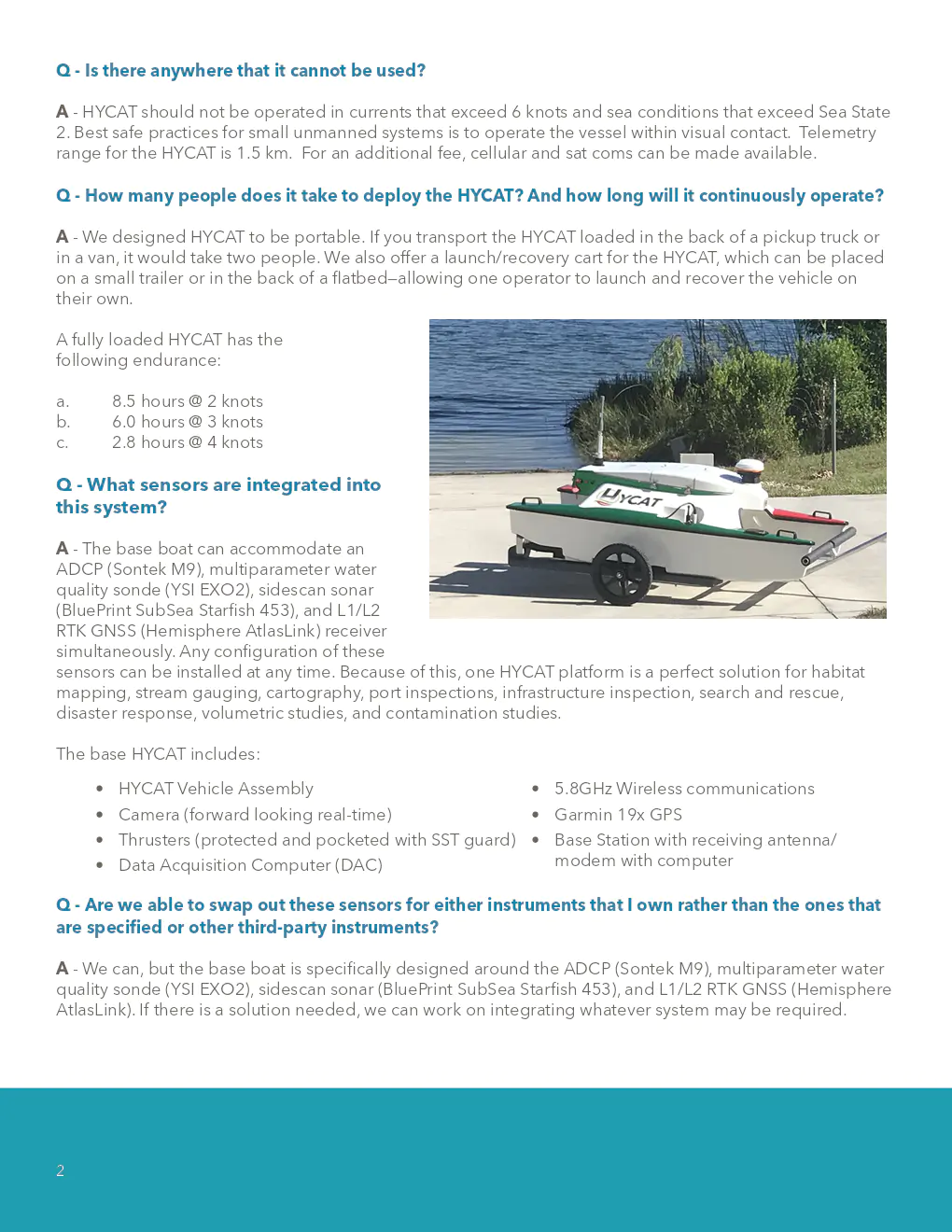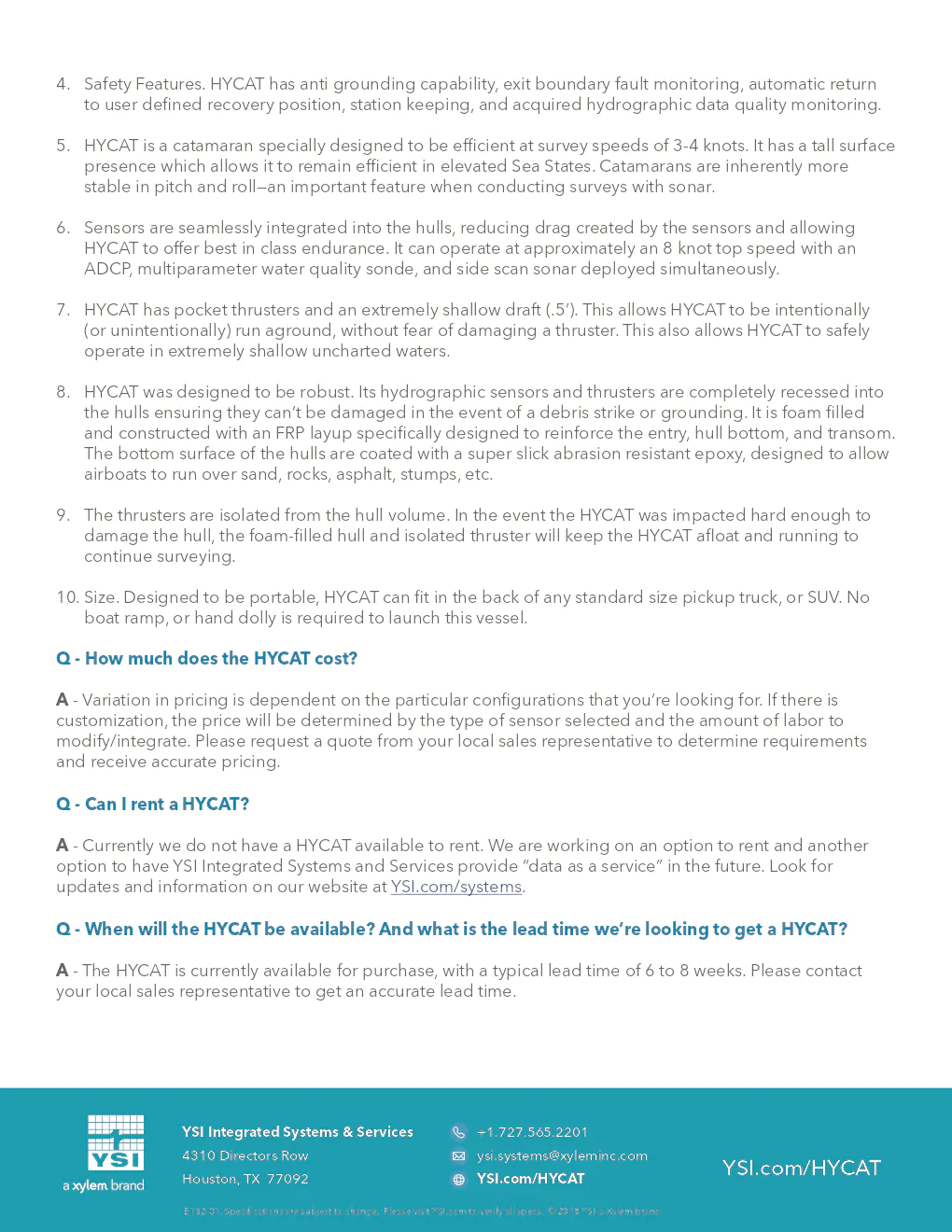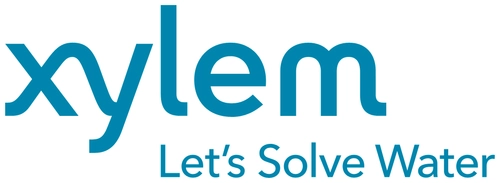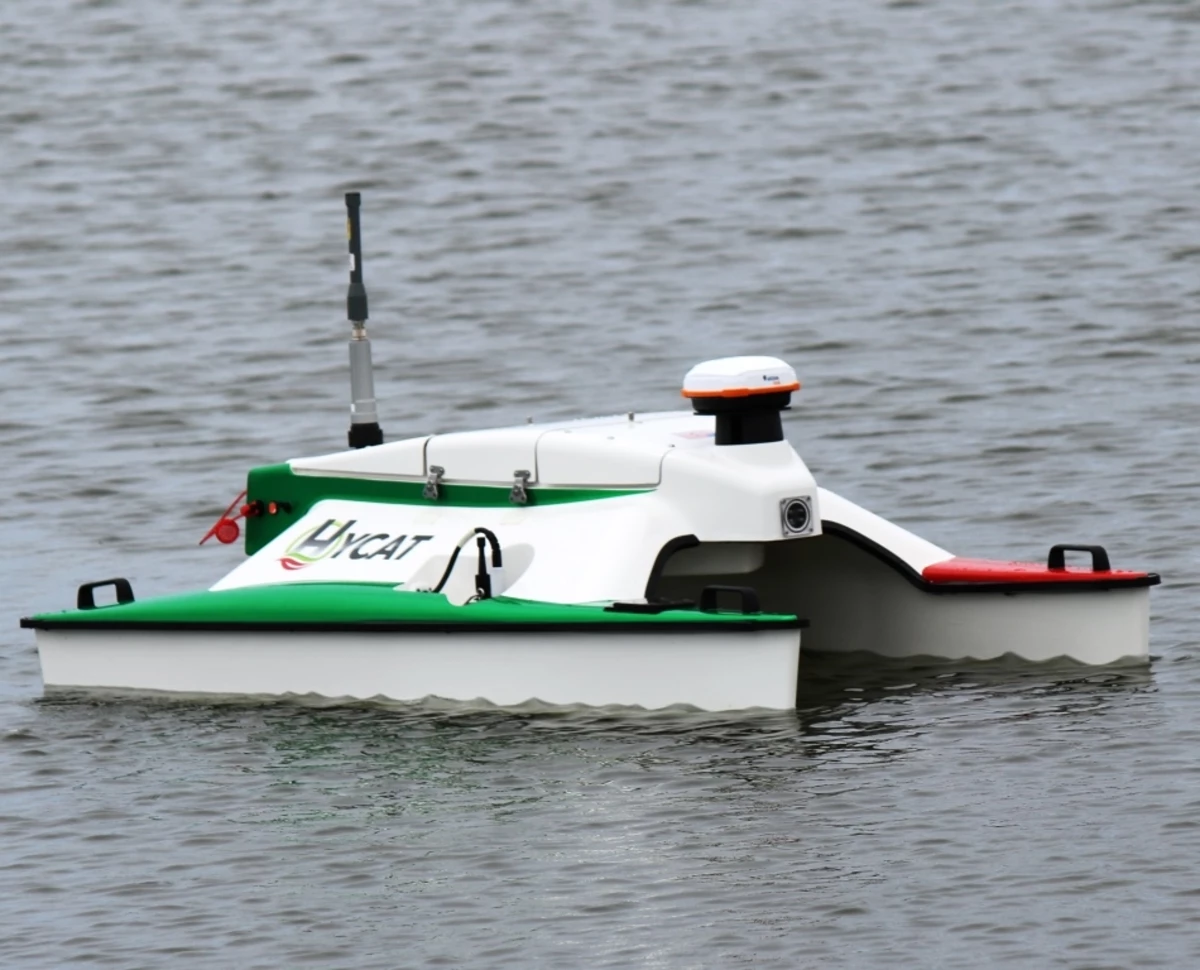Document
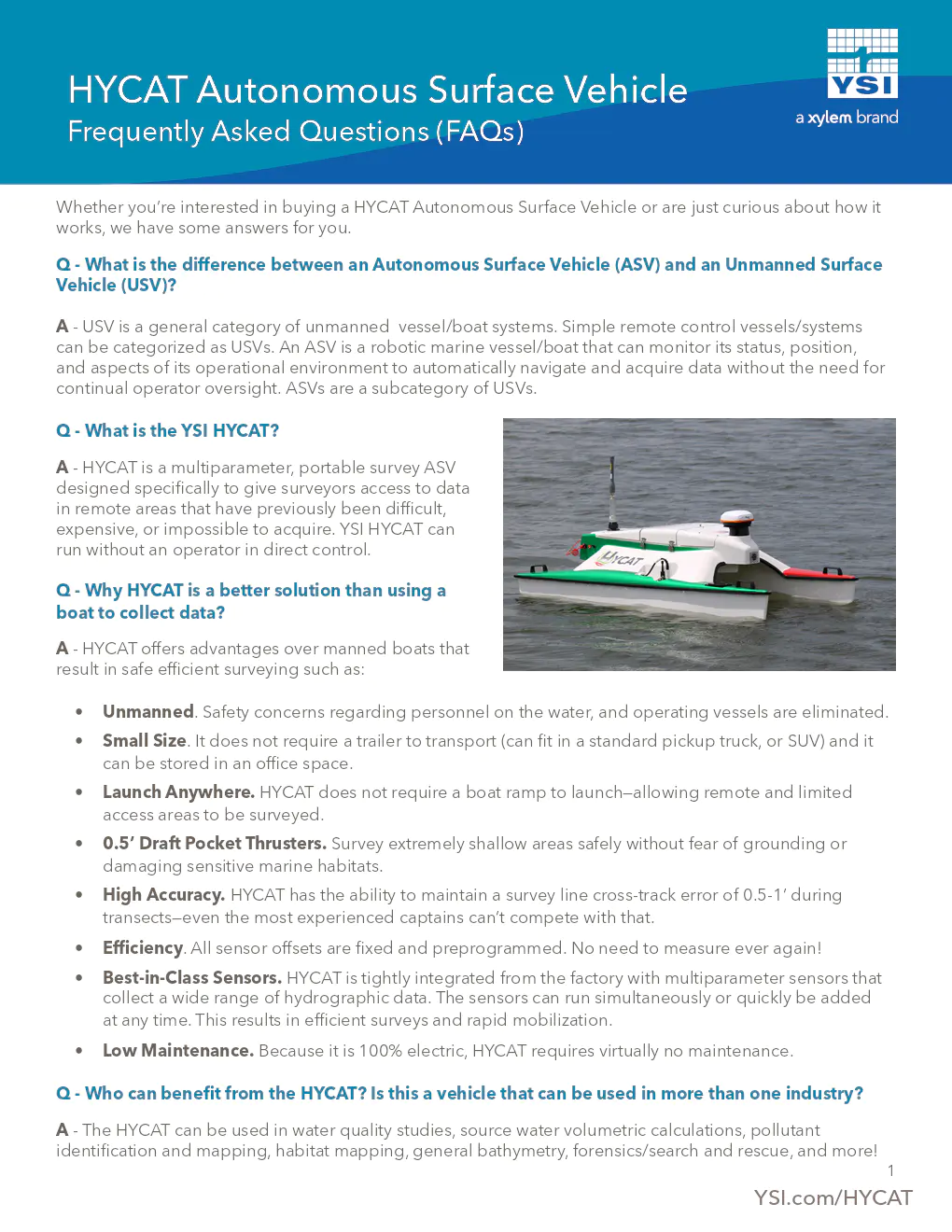
YSI-HYCAT-Frequently-Asked-Questions-FAQs

Contenu du document
Q - What is the difference between an Autonomous Surface Vehicle (ASV) and an Unmanned Surface
Vehicle (USV)?
A - USV is a general category of unmanned vessel/boat systems. Simple remote control vessels/systems
can be categorized as USVs. An ASV is a robotic marine vessel/boat that can monitor its status, position,
and aspects of its operational environment to automatically navigate and acquire data without the need for
continual operator oversight. ASVs are a subcategory of USVs.
Q - What is the YSI HYCAT?
A - HYCAT is a multiparameter, portable survey ASV
designed specifically to give surveyors access to data
in remote areas that have previously been difficult,
expensive, or impossible to acquire. YSI HYCAT can
run without an operator in direct control.
Q - Why HYCAT is a better solution than using a
boat to collect data?
A - HYCAT offers advantages over manned boats that
result in safe efficient surveying such as:
• Unmanned . Safety concerns regarding personnel on the water, and operating vessels are eliminated.
• Small Size . It does not require a trailer to transport (can fit in a standard pickup truck, or SUV) and it
can be stored in an office space.
• Launch Anywhere. HYCAT does not require a boat ramp to launch—allowing remote and limited
access areas to be surveyed.
• 0.5’ Draft Pocket Thrusters. Survey extremely shallow areas safely without fear of grounding or
damaging sensitive marine habitats.
• High Accuracy. HYCAT has the ability to maintain a survey line cross-track error of 0.5-1’ during
transects—even the most experienced captains can’t compete with that.
• Efficiency . All sensor offsets are fixed and preprogrammed. No need to measure ever again!
• Best-in-Class Sensors. HYCAT is tightly integrated from the factory with multiparameter sensors that
collect a wide range of hydrographic data. The sensors can run simultaneously or quickly be added
at any time. This results in efficient surveys and rapid mobilization.
• Low Maintenance. Because it is 100% electric, HYCAT requires virtually no maintenance.
Q - Who can benefit from the HYCAT? Is this a vehicle that can be used in more than one industry?
A - The HYCAT can be used in water quality studies, source water volumetric calculations, pollutant
identification and mapping, habitat mapping, general bathymetry, forensics/search and rescue, and more!
HYCAT Autonomous Surface Vehicle
Frequently Asked Questions (FAQs)
Whether you’re interested in buying a HYCAT Autonomous Surface Vehicle or are just curious about how it
works, we have some answers for you.
YSI.com/HYCAT
1
Q - Is there anywhere that it cannot be used?
A - HYCAT should not be operated in currents that exceed 6 knots and sea conditions that exceed Sea State
2. Best safe practices for small unmanned systems is to operate the vessel within visual contact. Telemetry
range for the HYCAT is 1.5 km. For an additional fee, cellular and sat coms can be made available.
Q - How many people does it take to deploy the HYCAT? And how long will it continuously operate?
A - We designed HYCAT to be portable. If you transport the HYCAT loaded in the back of a pickup truck or
in a van, it would take two people. We also offer a launch/recovery cart for the HYCAT, which can be placed
on a small trailer or in the back of a flatbed—allowing one operator to launch and recover the vehicle on
their own.
A fully loaded HYCAT has the
following endurance:
a. 8.5 hours @ 2 knots
b. 6.0 hours @ 3 knots
c. 2.8 hours @ 4 knots
Q - What sensors are integrated into
this system?
A - The base boat can accommodate an
ADCP (Sontek M9), multiparameter water
quality sonde (YSI EXO2), sidescan sonar
(BluePrint SubSea Starfish 453), and L1/L2
RTK GNSS (Hemisphere AtlasLink) receiver
simultaneously. Any configuration of these
sensors can be installed at any time. Because of this, one HYCAT platform is a perfect solution for habitat
mapping, stream gauging, cartography, port inspections, infrastructure inspection, search and rescue,
disaster response, volumetric studies, and contamination studies.
The base HYCAT includes:
• HYCAT Vehicle Assembly • 5.8GHz Wireless communications
• Camera (forward looking real-time) • Garmin 19x GPS
• Thrusters (protected and pocketed with SST guard) • Base Station with receiving antenna/
modem with computer • Data Acquisition Computer (DAC)
Q - Are we able to swap out these sensors for either instruments that I own rather than the ones that
are specified or other third-party instruments?
A - We can, but the base boat is specifically designed around the ADCP (Sontek M9), multiparameter water
quality sonde (YSI EXO2), sidescan sonar (BluePrint SubSea Starfish 453), and L1/L2 RTK GNSS (Hemisphere
AtlasLink) . If there is a solution needed, we can work on integrating whatever system may be required.
2
YSI.com/HYCAT
Q - How many software packages does it take to effectively run the HYCAT? And how difficult is it to
run? Do we provide training on that?
A - Only one software is required. The main interface is HYPACK, and training is recommended for those
who are not familiar with HYPACK software. The main purpose of the training is to understand how to
mission plan, utilize underway display/control and post mission data processing/visualization. Survey or
Mission planning is relatively simple with HYPACK and the vehicle operation is also very straightforward.
Q - What is different about the HYCAT compared to other ASV/USV on the market?
Several attributes put HYCAT in a league of its own:
1. HYCAT has a dedicated ASV driver for HYPACK. This increases the safety and intuitiveness of HYCAT
because there is only one interface for the system. Map-based survey plans can be created and
executed in real time. All acquired data can be visualized in real time via the same interface. This
simplifies training and reduces the overhead associated with learning how to operate this system.
2. HYCAT has an onboard Windows PC dedicated to data acquisition. This allows HYCAT to simultaneously
store data onboard and stream it shoreside. Onboard data storage is a major advantage over
systems that solely stream data shoreside or to the cloud. Data is lost when these systems experience
communication drop outs and surveyors are required to recreate surveys to fill in data gaps. HYCAT
is unaffected by loss of communications. The onboard computer allows HYCAT to continue following
survey lines and collecting data even in the event of a drop in communications to the shoreside base
station. It is important to note that while HYCAT data is stored onboard it can be visualized, edited, and
even post processed in real time.
3. As a truly robotic system, HYCAT has many fail safes and processing that allows it to continually adjust
its behaviors and report its status. Such parameter protections include but are not limited to: electronics
temperatures, motor temperatures, system current, motor currents, under voltage, over voltage, GPS
data quality, heading data quality, communications link quality, real time battery capacity, sensor on/off
status, etc.
3
YSI.com/HYCAT
E132-01. Specifications are subject to change. Please visit YSI.com to verify all specs. © 2018 YSI, a Xylem brand
YSI Integrated Systems & Services
4310 Directors Row
Houston, TX 77092
+1.727.565.2201
ysi.systems@xyleminc.com
YSI.com/HYCAT
4. Safety Features. HYCAT has anti grounding capability, exit boundary fault monitoring, automatic return
to user defined recovery position, station keeping, and acquired hydrographic data quality monitoring.
5. HYCAT is a catamaran specially designed to be efficient at survey speeds of 3-4 knots. It has a tall surface
presence which allows it to remain efficient in elevated Sea States. Catamarans are inherently more
stable in pitch and roll—an important feature when conducting surveys with sonar.
6. Sensors are seamlessly integrated into the hulls, reducing drag created by the sensors and allowing
HYCAT to offer best in class endurance. It can operate at approximately an 8 knot top speed with an
ADCP, multiparameter water quality sonde, and side scan sonar deployed simultaneously.
7. HYCAT has pocket thrusters and an extremely shallow draft (.5’). This allows HYCAT to be intentionally
(or unintentionally) run aground, without fear of damaging a thruster. This also allows HYCAT to safely
operate in extremely shallow uncharted waters.
8. HYCAT was designed to be robust. Its hydrographic sensors and thrusters are completely recessed into
the hulls ensuring they can’t be damaged in the event of a debris strike or grounding. It is foam filled
and constructed with an FRP layup specifically designed to reinforce the entry, hull bottom, and transom.
The bottom surface of the hulls are coated with a super slick abrasion resistant epoxy, designed to allow
airboats to run over sand, rocks, asphalt, stumps, etc.
9. The thrusters are isolated from the hull volume. In the event the HYCAT was impacted hard enough to
damage the hull, the foam-filled hull and isolated thruster will keep the HYCAT afloat and running to
continue surveying.
10. Size. Designed to be portable, HYCAT can fit in the back of any standard size pickup truck, or SUV. No
boat ramp, or hand dolly is required to launch this vessel.
Q - How much does the HYCAT cost?
A - Variation in pricing is dependent on the particular configurations that you’re looking for. If there is
customization, the price will be determined by the type of sensor selected and the amount of labor to
modify/integrate. Please request a quote from your local sales representative to determine requirements
and receive accurate pricing.
Q - Can I rent a HYCAT?
A - Currently we do not have a HYCAT available to rent. We are working on an option to rent and another
option to have YSI Integrated Systems and Services provide “data as a service” in the future. Look for
updates and information on our website at YSI.com/systems .
Q - When will the HYCAT be available? And what is the lead time we’re looking to get a HYCAT?
A - The HYCAT is currently available for purchase, with a typical lead time of 6 to 8 weeks. Please contact
your local sales representative to get an accurate lead time.
Entreprises concernées :
Produits concernés :
Date d'upload du document :
jeudi 11 mars 2021
